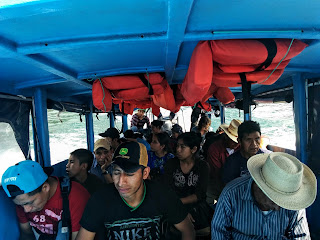We didn't have reservations when we
arrived in San Marcos on Lake Atitlan, Guatemala, but we had a few
accommodation ideas in mind. Our first stop was Hotel Aaculaax (aka
Lush). The super fancy, manicured grounds and abundance of impressive
design details had me doubting it's affordability immediately.
However, because we were possibly the luckiest people alive they had
2 budget rooms available. Lush (as I think they prefer to be called
now) had a beautifully decorated spacious room for Q120 ($16USD) and
another smaller oddly shaped, but still atmospheric room for Q100
($13USD). We scooped up the bigger room and were pretty impressed
with our score. The room was a warm yellow and decorated with a
combination of glass and tile mosaics, 3D stained glass, funky wood
furniture and rock slab shelves. It was one of the most unique rooms
we've ever stayed in. The bathroom, shared between the 2 rooms, was
practically a piece of art. With so much colour, murals, stonework
and stained glass, I can safely say that it is the only bathroom that
I have ever taken a panoramic picture in. Bonus- it was always super
clean. There was a huge, beautiful terrace entwined with vines,
flowers and rustic wood. The tables were slabs of huge trees and the
chairs had thick, colourful woven cushions. Tropical birds and
hummingbirds flitted around the spectacularly lush, dense gardens
constantly. Honestly, it was a little slice of lake front paradise
and I can barely believe that we cheapos got to stay there.
There were more expensive rooms too,
which would definitely be worth the splurge, if you were so inclined.
The main difference between our room and the expensive ones- was the
view. If I were to pick one bad thing about Hotel Aaculaax it would
be that there isn't a general area to relax with a lake view. While
the gardens are gorgeous, we're all really here for the lake. My
guess is that this luxury is reserved for the people willing to fork
out the cash. Fairly, I suppose. We met an awesome couple from Alaska
who were nice enough to show us their fancier room (about $50USD) in
which their bed was set into a huge bay window (that opened!!) with a
spectacular view of the lake. It's hard to imagine a nicer place to
wake up. The more expensive rooms (which go up to $100 USD) had
balconies and huge windows, all which had (I'm assuming)
I-have-to-sit-here-all-day type of views. Many of these rooms are
actually apartments, so if you did splurge for a fancy room, maybe
you could save a few bucks and cook dinner for yourself, although its
hard to imagine wanting to tear your gaze away from your view for
that long.
Speaking of beds- ours was super
comfortable, which is a luxury in itself, and the pillows had nare a
lump in them, which is practically impossible to find in our
experience. And the wifi was by far the strongest and most reliable
we've seen in Central America. Oh the perks of staying at an adult
hotel!
The staff were friendly and spoke
English. You could get beer (a bit expensive) at reception, and
breakfast (also expensive) on the lovely terrace. You can't reserve
the cheaper rooms in advance, so its really a game of luck if that's
what you're looking for. However, if you are considering the long
haul, Lush offers the 8th night free if you stay 7 (at
least for the cheap rooms). We would definitely stay here again if we were lucky enough to find ourselves back in San Marcos La Laguna.















































